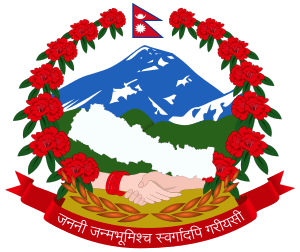Thapa dynasty
| Thapa noble family थापा वंश/थापा काजी खलक | |
|---|---|
| Country | Kingdom of Nepal |
| Ethnicity |
Khas Kshatriya (Chhetri)
|
| Founded | 1806 |
| Founder | Bhimsen Thapa |
| Current head | currently as pretender |
| Final ruler | Mathabarsingh Thapa |
| Titles | Title of Kaji |
| Style(s) |
|
| Religion | Hinduism |
| Estate(s) |
Bhimsen Tower Bag Durbar Thapathali Durbar Chhauni Durbar |
| Deposition | 1845 |
.jpg)
Thapa or Thapa noble family (Nepali: थापा वंश/थापा काजी खलक [t̪ʰāpā bəmsə]) is a Kshatriya (Chhetri) political family[1] that handled Nepali administration affairs between 1806 and 1837 A.D. and 1843 to 1845 A.D.[2] as Mukhtiyar (Prime Minister). This was one of the four noble families to be involved in the active politics of Nepal, along with the Shah dynasty, Basnyat family, and the Pande before the rise of the Rana .[1] At the end of 18th century, Thapas had extreme dominance over Nepalese Darbar politics alternatively contesting for central power against the Pandes.[3] The dynasty was established by leading patron Bhimsen Thapa of the Bagale Thapa clan.[4] The Thapa family gave rise to the Rana of Jung Bahadur Kunwar Rana whose father Bal Narsingh Kunwar was the son-in-law of Thapa Kaji Nain Singh Thapa. Similarly, this dynasty was connected to the Pande aristocratic family through Nain Singh Thapa who was the son-in-law of once Mulkaji Ranajit Pande[5]
Ethnic and political background
The Thapa dynasty comes from the family of Kaji Bir Bhadra Thapa, commander of Unification of Nepal who belonged to the Bagale Thapa clan. He had three sons: Jeevan Thapa (died at the Battle of Kirtipur), Bangsha Raj Thapa, and Amar Singh Thapa (Sardar).[6] The eldest son of Amar Singh Thapa (Sardar) was Bhimsen Thapa who later became an essential ruler in Nepalese history.[7]
The rise of Thapas
.jpg)
The family became prominent during the rule of King Prithvi Narayan Shah and were established as a dominant faction during the reign of King Rana Bahadur Shah.[8] After the assassination of King Rana Bahadur Shah, Bhimsen Thapa rose to the event killing all enemies and proving the strength and presence of the Thapa family in the Royal Court of Nepal.[9] He went on to become the second Prime Minister of Nepal[6] and thus founded the Thapa family in the political context of Nepal.[10] Afterwards, the Thapas took the stronghold of the military power with an absolute order, which leads to a rivalry among other nobles.[11]
Thapas on power
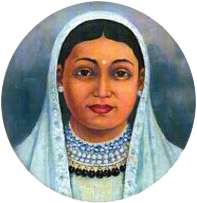
Tripurasundari was the daughter of Bhimsen's brother, Kazi Nain Singh Thapa.[12] After the chaos that followed King Rana Bahadur's murder, Bhimsen became the Mukhtiyar and his niece Tripurasundari was given the title Lalita Tripurasundari and declared regent and Queen Mother of Nepal.[13] The Thapa family remained in power continuously even after the death of King Girvan Yuddha Bikram Shah and even after the peace deal (sugauli shandi) with the east india trade company (BRITISH) done between the then ruling prime minister Bhimsen Thapa representative of Nepal and British .[14] The modernization of the Nepalese Army was done to keep things in control[15] while convincing the suspicious British of no intention to use. Bhimsen increased his family members in court and military and also transferred other aristocratic families away from the capital.[16] Bhimsen instated his youngest brother, General Ranabir Singh Thapa, in the royal palace as chief palace authority.[17] Any meetings between the royal family and commoners or Bhardars were done under his permission and observation.[17]
The downfall of Thapas
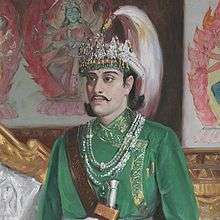
Bhimsen had committed atrocities against the Pande family by being involved in the execution of Nepalese Chief Kazi Damodar Pande. Rana Jang Pande, the youngest son of Damodar Pande, was a supporter of Senior Queen Samrajya Laxmi and had planned for the downfall of the thirty-one year Thapa rule.[18] In the Nepalese court, the rivalry between the two queens rose where the Senior Queen supported the Pandes, while the Junior Queen supported the Thapas.[19] Bhimsen went to his ancestral home in Gorkha for some time making Ranabir Singh Thapa as Acting Mukhtiyar.[20] Rana Jang Pande, the leading member of Pande aristocratic family and his brother, Ranadal Pande, was elevated in the Nepal Darbar.[21]
On 24 July 1837, King Rajendra Bikram Shah's infant son, Devendra Bikram Shah, died.[21][22] Bhimsen and members of the Thapa faction were blamed.[22][23][24] On this charge, Bhimsen and whole the Thapa family, the court physicians, Ekdev and Eksurya Upadhyay, and his deputy Bhajuman Baidya, with relatives of the Thapas were incarcerated, proclaimed outcasts, and their properties confiscated.[22][23][25][26]
Fatte Jang Shah, Rangnath Poudel, and the Junior Queen Rajya Laxmi Devi, the anti-Pande faction, obtained from the King the liberation of Bhimsen, Mathabar, and the rest of the party, about eight months after they were incarcerated for the poisoning case.[27][28][29] Confiscation of some properties was pardoned. The pro-Thapa soldiers rallied to Bhimsen, Mathabar Singh, and Sherjung Thapa's houses.[30] Mathabar Singh fled to India while pretending to go on a hunting trip; Ranbir Singh gave up all his property and became a sanyasi, titling himself Swami Abhayananda; but Bhimsen Thapa preferred to remain in his old home in Gorkha.[29][31]
The final chapter of Thapas
The resurrection of Thapa
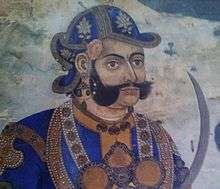
Mathabarsingh Thapa fled to India when Bhimsen Thapa and Thapa courtiers were punished.[29][32] Sher Jung Thapa and other jailed Thapa members were pardoned on the request of Junior Queen after the death of Senior Queen.[33] Mathabar, the most senior Thapa, was requested to return to Nepal by then ruling Junior Queen Rajya Laxmi after six years of exile.[34] Mathabarsingh Thapa arrived in Kathmandu Valley on 17 April 1843 where he was greeted with state honors.[35] He then re-opened the murder case of his uncle and godfather Bhimsen Thapa, and members of Pande faction and their supporters were executed.[36]
End of Thapas
The murder of Mathabar Singh on 17 May 1845 by his nephew, Janga Bahadur Kunwar, on the orders of King Rajendra Bikram Shah and his Junior Queen, ended the Thapa family's rule in Nepal giving rise to Agnatic Rana dynasty.[37]
Family palaces
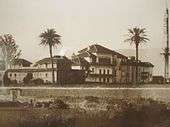
The family resided at Thapathali Durbar and Bagh Durbar. Bagh Durbar was constructed by Bhimsen Thapa, who moved to reside near the Basantapur Palace. He initially moved from Gorkha district to Thapathali Durbar and eventually to Bagh Durbar.[38]

Bagh Durbar, which literally means The Tiger's Mansion, was built in 1805 A.D. by PM Bhimsen Thapa. It had a spacious Janarala Bagh (General's Garden), a pond and many temples glorifying the Mukhtiyar General. When Thapa rule was revived, PM Mathabarsingh Thapa recaptured the lost palace and resided there for two years.[39]
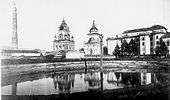
The National Museum of Nepal at Chhauni was once a residence to Prime Minister Bhimsen Thapa. The building has collection of bronze sculptures, paubha paintings and weapons including the sword gifted by King of France Napoleon Bonaparte.[40]
Thapa family members
| No. | Members | Image | Position | Years ruled | Notes |
|---|---|---|---|---|---|
| 1 | Bhimsen Thapa | .jpg) | Mukhtiyar (Prime Minister) and Commander-in-Chief | 1806 to 1837 A.D. | |
| 2 | Ranabir Singh Thapa | 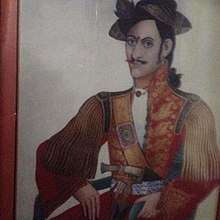 | Acting Mukhtiyar (Acting Prime Minister)[20] | 1837 A.D. (briefly) | |
| 3 | Mathabarsingh Thapa | 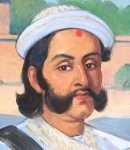 | Prime Minister and Commander-in-Chief | 1843 to 1845 A.D. | |
| 4 | Queen Tripurasundari of Nepal |  | Queen Consort and Mother Regent of Nepal | 1805 to 1832 A.D. | |
| 5 | Bir Bhadra Thapa | Jetha Buda and Bhardar | He is the male patriarch of this dynasty and the senior Bharadar (politician) of the Gorkha Kingdom | ||
| 6 | Sanukaji Amar Singh Thapa | Governor and Sardar | Distinguished from Commander of Western forces Badakaji Amar Singh Thapa by terms Bada (Senior) and Sanu (Junior) | ||
| 7 | Nain Singh Thapa | 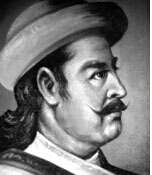 | General and Minister (Kaji) | ||
| 8 | Ujir Singh Thapa | 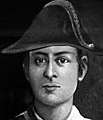 | Governor and Colonel | son of Nain Singh Thapa[41] | |
| 9 | Bhaktabar Singh Thapa | Colonel | Brother of Bhimsen | ||
| 10 | Sher Jung Thapa | Colonel | Nephew and adopted son of Bhimsen | ||
| 11 | Amrit Singh Thapa | Kaji | Brother of Bhimsen, involved in bringing back Balbhadra Kunwar at Dehradun[42] | ||
| 12 | Ranzawar Thapa | Step-brother of Bhimsen | |||
| 13 | Ranabam (Bhotu) Thapa | Step-brother of Bhimsen | |||
| 14 | Tilak (Tri) Bikram Singh Thapa | Kaji | Known popularly as Kaji Mama by Shamsher Ranas; son of Bhaktawar Singh | ||
| 15 | Ranojjwal Singh Thapa | Son of Mathabarsingh Singh | |||
| 16 | Bikram Singh Thapa | Colonel | Son of Mathabarsingh Singh |
Family Tree of Bir Bhadra Thapa
| Bir Bhadra Thapa | |||||||||||||||||||||||||||||||||||||||||||||||||||||
| Jiwan Thapa | Bangsha Raj Thapa | Satyarupa Maya | Amar Singh Thapa (sanu) | ? | |||||||||||||||||||||||||||||||||||||||||||||||||
| Bhimsen Thapa | Nain Singh Thapa | Bhaktawar Singh Thapa | Amrit Singh Thapa | Ranabir Singh Thapa | Ranbam Thapa | Ranzawar Thapa | |||||||||||||||||||||||||||||||||||||||||||||||
| ? (son died young) | Lalita Devi Pande | Janak Kumari Pande | Dirgha Kumari Pande | ||||||||||||||||||||||||||||||||||||||||||||||||||
Separate Family tree of Kazi Nain Singh Thapa:
| Nain Singh Thapa | Rana Kumari Pande | ||||||||||||||||||||||||||||||||||||||||
| Ganesh Kumari Kunwar | Queen Tripurasundari of Nepal (born 1794) | Ujir Singh Thapa (born 1796) | Mathabarsingh Thapa (born 1798) | ||||||||||||||||||||||||||||||||||||||
| Ranojjwal Singh Thapa | Bikram Singh Thapa | Amar Singh Thapa II | |||||||||||||||||||||||||||||||||||||||
Other Thapa nobles
The unrelated family of Amar Singh Thapa was also included in broader Thapa caucus.[45]
| No. | Other Members | Image | Position | Years active | Notes |
|---|---|---|---|---|---|
| 1 | Badakaji Amar Singh Thapa | 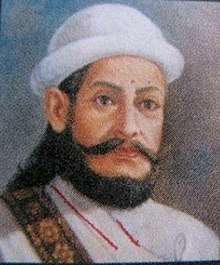 |
Kaji and General of Nepal | 1759-1816 AD | Distinguished from father of Bhimsen Thapa and Palpa Administrator Sanukaji Amar Singh Thapa by terms Bada (Senior) and Sanu (Junior) |
| 2 | Bhakti Thapa | 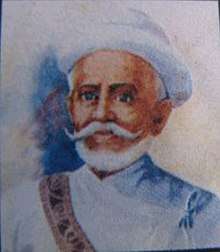 |
Sardar of Nepal Army | died 1815 AD | No blood relations to both Bhimsen Thapa and Badakaji Amar Singh Thapa |
| 3 | Ranadhoj Thapa | Deputy Prime Minister of Nepal | retired on 1831 | eldest son of Badakaji Amar Singh Thapa[46] | |
| 4 | Ranajor Singh Thapa | Kaji and Colonel of Nepal | youngest son of Badakaji Amar Singh Thapa[46] | ||
| 5 | Surath Singh Thapa | Kaji (later Captain only) and Joint-Chief signatory of Darbar[47] | appointed on 1832 | grandson of Badakaji Amar Singh Thapa | |
| 6 | Bhaktabir Thapa | Captain and later Kaji | retired on 1839 | second son of Badakaji Amar Singh Thapa[46] | |
| 7 | Narsingh Thapa | Captain and Kaji alternatively | appointed on 1818 | third son of Badakaji Amar Singh Thapa[46] | |
| 8 | Megraj Thapa | Unknown | 2003 - .... | great x5 grandson of Ranadhoj Thapa |
Allies and opponents
List of Allies during Transition Phase (1837–1846)
| No. | Name | Type | Noted | |
|---|---|---|---|---|
| 1 | Ranganath Paudel | Mostly allied | Known strong supporter of Bhimsen Thapa. | |
| 2 | Junior Queen Rajya Laxmi of Nepal | Mostly allied but later switched alliance | Lastly, she supported attack on Thapas in 1845.[37] | |
| 3 | Fateh Jung Shah | Mildly allied | Supported the release of Thapas in 1837.[27] | |
| 4 | Gora Pande faction | Mild supporter | Known supporter and relatives of Thapa faction through Nain Singh Thapa. |
List of Opponents during Transition Phase (1837–1846)
| No. | Name | Type | Noted |
|---|---|---|---|
| 1 | Kala Pande faction | Strong opponent | Known strong opponent of Thapa faction. |
| 2 | Rajendra Bikram Shah and Senior Queen Samrajya Laxmi | Strong opponent | Known strong opponent of Thapa faction. |
| 3 | Basnyat family | Mild | Favoured Pandes over Thapas due to previous marital ties. |
| 4 | Kunwar faction (Rana dynasty) | Former Alliance grew strong opponent. | Nephew Jung Bahadur Rana ended Thapa hegemony.[37] |
| 5 | Chautariya Pushkar Shah | Mild |
Favoured Pandes[48] over Thapas. |
| 6 | Brian Hodgson | Strong opponent but later sympathized. | Known strong opponent of Bhimsen Thapa but later sympathized Bhimsen.[49] |
Works
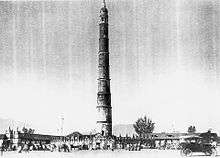
Dharahara tower was built by Mukhtiyar Bhimsen Thapa.[50] Dharahara is said to be built for Queen Tripurasundari of Nepal, who was the niece of Bhimsen Thapa.[51]
Present day descendants
The Thapa dynasty under Bhimsen Thapa fell after the murder of Mathabarsingh Thapa by his nephew, Jung Bahadur Rana. Colonel Bikram Singh Thapa was the son of Mathabarsingh and the only remaining Thapa member in the Nepalese court till the coup-de-Etat of 1885. After his death, his properties were confiscated, and his descendants were termed outcasts.[52]
Since Bhimsen did not have a male heir, the male descendants of his brothers are the pretenders of this dynasty. Few descendants of Mathabarsingh have adopted the middle name Barsingh as a patronymic name derived from their ancestor while others have common Kshatriya titles Bikram and Singh. Former Secretary of the Education Ministry, Dipendra Bikram Thapa is the sixth descendant of Mathabarsingh Thapa who went on to become the first person to pass the examination of Joint-Secretary from the open category.[52] Other descendants of Mathabarsingh include another Senior Official, Sharada Bikram Thapa, Former Acting Dean of TU Prof. Sita Maiya Singh Thapa and NGO worker Minu Maiya Singh[52] Similarly, DIG of Nepal Police Sushil Barsingh Thapa and Lt.Col. Rajeev Barsingh Thapa is the sixth descendants of Mathabarsingh Thapa.[52] Sushil Barsingh went on to retire as AIG of Nepal Police.[53] Brother of Sushil Barsingh, Dr. Suman Thapa is a Medical Doctor at Shukraraj Tropical Hospital, and the youngest brother Manoj Barsingh Thapa is a police officer at the intelligence department of Police while his nephew Nishil Barsingh Thapa is a military officer.[52]
Gallery
 Clothes worn by Mukhtiyar Bhimsen Thapa
Clothes worn by Mukhtiyar Bhimsen Thapa Clothes worn by Mukhtiyar Bhimsen Thapa
Clothes worn by Mukhtiyar Bhimsen Thapa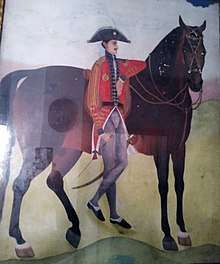 Picture of Bhimsen Thapa standing beside a horse
Picture of Bhimsen Thapa standing beside a horse PM Mathabar Singh Thapa in crown
PM Mathabar Singh Thapa in crown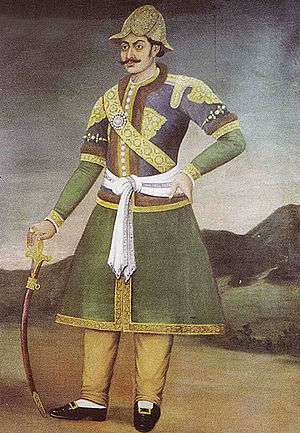 Portrait of Mukhtiyar General Bhimsen Thapa
Portrait of Mukhtiyar General Bhimsen Thapa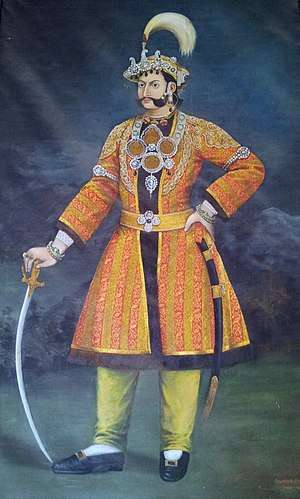 Portrait of first titled Prime Minister Mathabar Singh Thapa
Portrait of first titled Prime Minister Mathabar Singh Thapa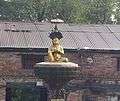 Statue of Queen Tripurasundari
Statue of Queen Tripurasundari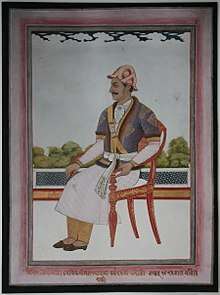 Portrait of Mukhtiyar General Bhimsen Thapa
Portrait of Mukhtiyar General Bhimsen Thapa Portrait of Colonel Mathabar Singh Thapa from 1831
Portrait of Colonel Mathabar Singh Thapa from 1831 Portrait of Mathabar Singh Thapa
Portrait of Mathabar Singh Thapa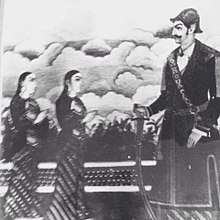 Bhimsen Thapa and two wives
Bhimsen Thapa and two wives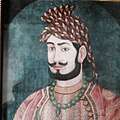 Mathabar Simha Thapa in Panjabi court
Mathabar Simha Thapa in Panjabi court Portrait of Ranabir Singh Thapa
Portrait of Ranabir Singh Thapa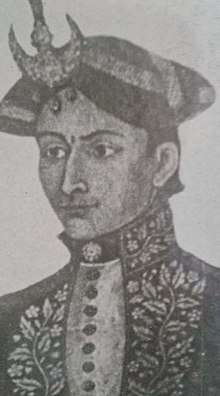 Portrait of Ujir Singh Thapa
Portrait of Ujir Singh Thapa Portrait of Ranabir Singh Thapa as Swami Abhayananda
Portrait of Ranabir Singh Thapa as Swami Abhayananda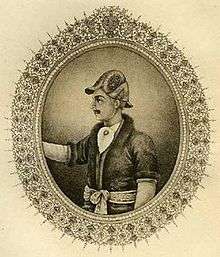 Bhimsen Thapa,
Bhimsen Thapa,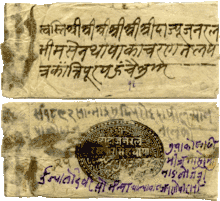 General Ranabir Singh Thapa's letter signed by his private black seal sent to Mukhtiyar (PM) Bhimsen Thapa and 2nd Kazi (Deputy PM) Ranadhoj Thapa
General Ranabir Singh Thapa's letter signed by his private black seal sent to Mukhtiyar (PM) Bhimsen Thapa and 2nd Kazi (Deputy PM) Ranadhoj Thapa Letter sent to PM Bhimsen Thapa and Kazi Ranadhoj Thapa by (Pvt. seal L to R) Bakhat Singh Sardar, Dalbhanjan Pande (Pande Kazi), Ranabir Singh Thapa, Kaji Narsingh Thapa (Elder Amar Singh Thapa's another son) and sundry captains
Letter sent to PM Bhimsen Thapa and Kazi Ranadhoj Thapa by (Pvt. seal L to R) Bakhat Singh Sardar, Dalbhanjan Pande (Pande Kazi), Ranabir Singh Thapa, Kaji Narsingh Thapa (Elder Amar Singh Thapa's another son) and sundry captains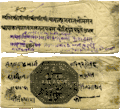 Letter sent to PM Bhimsen Thapa and Kazi Ranadhoj Thapa by then Colonel Mathabar Singh Thapa
Letter sent to PM Bhimsen Thapa and Kazi Ranadhoj Thapa by then Colonel Mathabar Singh Thapa
References
Notes
- 1 2 Joshi & Rose 1966, p. 23.
- ↑ Joshi & Rose 1966, p. 25.
- ↑ Pradhan 2012, p. 9.
- ↑ "Thapa and Shah families animosity". p. 26.
- ↑ JBR, PurushottamShamsher (1990). Shree Teen Haruko Tathya Britanta (in Nepali). Bhotahity, Kathmandu: Vidarthi Pustak Bhandar. ISBN 99933-39-91-1.
- 1 2 Pradhan 2012, p. 22.
- 1 2 Pradhan 2012, pp. 22-23.
- ↑ Pradhan 2012, pp. 21-22.
- ↑ Pradhan 2012, p. 16.
- ↑ Pradhan 2012, p. 16.
- ↑ Adhikari 2015, p. 120.
- ↑ Acharya 2012, p. 3.
- ↑ Acharya 2012, p. 71.
- ↑ Acharya 2012, pp. 74–75.
- ↑ Acharya 2012, p. 76.
- ↑ Acharya 2012, p. 77.
- 1 2 Acharya 2012, p. 148.
- ↑ Acharya 2012, p. 155.
- ↑ Nepal 2007, p. 108.
- 1 2 Acharya 2012, p. 157.
- 1 2 Acharya 2012, p. 158.
- 1 2 3 Nepal 2007, p. 105.
- 1 2 Acharya 2012, p. 159.
- ↑ Whelpton 2004, pp. 28–29.
- ↑ Acharya 1971, p. 13.
- ↑ Oldfield 1880, p. 310.
- 1 2 Oldfield 1880, p. 311.
- ↑ Nepal 2007, p. 109.
- 1 2 3 Acharya 2012, p. 161.
- ↑ Pradhan 2012, p. 164.
- ↑ Nepal 2007, p. 110.
- ↑ Oldfield 1880, p. 316.
- ↑ Acharya 2012, pp. 172-174.
- ↑ Acharya 2012, p. 177-178.
- ↑ Sharma, Balchandra (1976). Nepal ko Aitehasik Rooprekha. Varanasi: Krishna Kumari Devi. p. 295.
- ↑ Acharya 2012, pp. 179-181.
- 1 2 3 Acharya 2012, pp. 11-12.
- ↑ JBR, PurushottamShamsher (2007). Ranakalin Pramukh Atihasik Darbarharu [Chief Historical Palaces of the Rana Era] (in Nepali). Vidarthi Pustak Bhandar. ISBN 978-9994611027. Retrieved 12 May 2017.
- ↑ "Baghdurbar – The Tiger Palace | The Tara Nights". thetaranights.com. Retrieved 12 May 2017.
- ↑ "Kathmandu Valley | Places of Interest, Kathmandu, Bhaktapur, Patan City Tour, Typical City Tour , Unesco World heritage Sites Tour: Fishtail Tours & Travels Pvt. Ltd". fishtail.org. Retrieved 28 May 2017.
- ↑ Hamal 1995, p. 206.
- ↑ Pant 1978, p. 191.
- ↑ Joshi & Rose 1966.
- ↑ "History of the Nepalese Army". nepalarmy.mil.np. Archived from the original on 15 November 2017. Retrieved 18 June 2018.
- ↑ Pradhan 2012, p. 26.
- 1 2 3 4 Pradhan 2012, p. 195.
- ↑ Pradhan 2012, p. 148.
- ↑ Oldfield 1880, p. 313.
- ↑ Whelpton 2004, pp. 29-30.
- ↑ "Too tall for comfort". The Kathmandu Post. 11 January 2010. Retrieved 25 April 2015.
- ↑ Melissah Yang (25 April 2015). "Nepal Earthquake Destroys Dharahara Tower, A Significant Tourist Attraction In The Heart Of Kathmandu". Retrieved 25 April 2015.
- 1 2 3 4 5 "ampnews/2013-12-15/6239". nepal.ekantipur.com. Retrieved 2017-06-11.
- ↑ "Dr Dinesh Chandra Pokhrel is Nepal Police's Acting Chief". thehimalayantimes.com. Retrieved 11 June 2017.
Sources
- Joshi, Bhuwan Lal; Rose, Leo E. (1966), Democratic Innovations in Nepal: A Case Study of Political Acculturation, University of California Press, p. 551
- Pradhan, Kumar L. (2012), Thapa Politics in Nepal: With Special Reference to Bhim Sen Thapa, 1806–1839, New Delhi: Concept Publishing Company, p. 278, ISBN 9788180698132
- Oldfield, Henry Ambrose (1880), Sketches from Nipal, Vol 1, 1, London: W.H. Allan & Co.
- Shaha, Rishikesh (1982), Essays in the Practice of Government in Nepal, Manohar, p. 44, OCLC 9302577
- Adhikari, Indra, Military and Democracy in Nepal, Routledge, ISBN 978-1-317-58906-8
- Acharya, Baburam (2012), Acharya, Shri Krishna, ed., Janaral Bhimsen Thapa : Yinko Utthan Tatha Pattan (in Nepali), Kathmandu: Education Book House, p. 228, ISBN 9789937241748
- Nepal, Gyanmani (2007), Nepal ko Mahabharat (in Nepali) (3rd ed.), Kathmandu: Sajha, p. 314, ISBN 9789993325857
- Hamal, Lakshman B. (1995), Military history of Nepal, Sharda Pustak Mandir
- Whelpton, John (2004), "The Political Role of Brian Hodgson", in Waterhouse, David, Origins of Himalayan Studies: Brian Houghton Hodgson in Nepal and Darjeeling, Royal Asiatic Society Books (1 ed.), Taylor & Francis, p. 320, ISBN 9781134383634
- Pant, Mahesh Raj (1 December 1978). "The Battle of Nalapani" (PDF). Regmi Research Series. Kathmandu. 10 (11, 12): 167–170, 187–194. ISSN 0034-348X.
